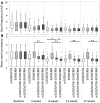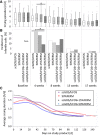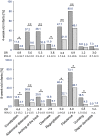Randomised controlled trial demonstrates that fermented infant formula with short-chain galacto-oligosaccharides and long-chain fructo-oligosaccharides reduces the incidence of infantile colic
- PMID: 28328065
- PMCID: PMC5485044
- DOI: 10.1111/apa.13844
Randomised controlled trial demonstrates that fermented infant formula with short-chain galacto-oligosaccharides and long-chain fructo-oligosaccharides reduces the incidence of infantile colic
Abstract
Aim: We examined the effects on gastrointestinal (GI) tolerance of a novel infant formula that combined specific fermented formula (FERM) with short-chain galacto-oligosaccharides and long-chain fructo-oligosaccharides (scGOS/lcFOS), with a 9:1 ratio and concentration of 0.8 g/100 mL.
Methods: This prospective, double-blind, randomised, controlled trial comprised 432 healthy, term infants aged 0-28 days whose parents decided to not start, or discontinued, breastfeeding. Infant formula with scGOS/lcFOS+50%FERM, scGOS/lcFOS+15%FERM, 50%FERM and scGOS/lcFOS were tested. Parents completed standardised seven-day diaries on GI symptoms, crying, sleeping and stool characteristics each month until the infants were 17 weeks.
Results: All the formulas were well tolerated. At four weeks, the overall incidence of infantile colic was significantly lower (8%) with scGOS/lcFOS+50%FERM than scGOS/lcFOS (20%, p = 0.034) or 50%FERM (20%, p = 0.036). Longitudinal modelling showed that scGOS/lcFOS+50%FERM-fed infants also displayed a persistently lower daily crying duration and showed a consistent stool-softening effect than infants who received formula without scGOS/lcFOS.
Conclusion: The combination of fermented formula with scGOS/lcFOS was well tolerated and showed a lower overall crying time, a lower incidence of infantile colic and a stool-softening effect in healthy term infants. These findings suggest for the first time that a specific infant formula has a preventive effect on infantile colic in formula-fed infants.
Keywords: Fermented formula; Gastrointestinal tolerance; Infant formula; Infantile colic; Prebiotic.
©2017 The Authors. Acta Paediatrica published by John Wiley & Sons Ltd on behalf of Foundation Acta Paediatrica.
Figures




References
-
- Agostoni C, Braegger C, Decsi T, Kolacek S, Koletzko B, Michaelsen KF, et al. Breast‐feeding: a commentary by the ESPGHAN Committee on Nutrition. J Pediatr Gastroenterol Nutr 2009; 49: 112–25. - PubMed
-
- Victora CG, Bahl R, Barros AJ, Franca GV, Horton S, Krasevec J, et al. Breastfeeding in the 21st century: epidemiology, mechanisms, and lifelong effect. Lancet 2016; 387: 475–90. - PubMed
-
- Wopereis H, Oozeer R, Knipping K, Belzer C, Knol J. The first thousand days ‐ intestinal microbiology of early life: establishing a symbiosis. Pediatr Allergy Immunol 2014; 25: 428–38. - PubMed
Publication types
MeSH terms
Substances
LinkOut - more resources
Full Text Sources
Other Literature Sources
Medical

